
Foreign Office Architects have completed the new tile-covered campus for Ravensbourne College of Design and Communication, located on the Greenwich Peninsula in London.
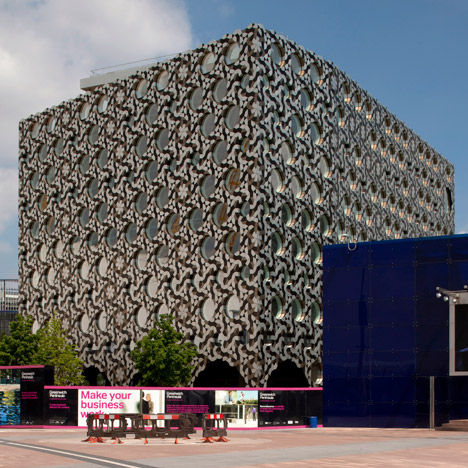
The façade is composed of 28,000 anodised aluminium tiles in three different shapes and colours.
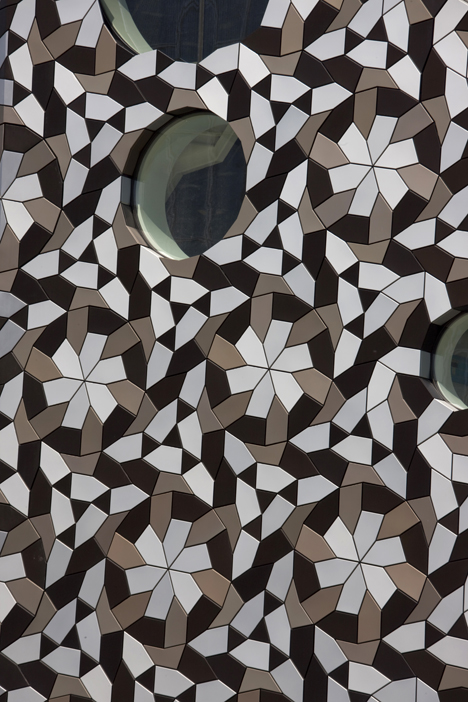
Above photographs are copyright Morley von Sternberg
The tiled façade is perforated with round windows of varying sizes, with two rows of windows per floor to provide views of the surrounding city.

The pattern of the tiles is determined by the size and positioning of window openings, while the size of windows depends on the corresponding interior function.

Perforations on the north side are larger and more frequent than those in the south side to regulate light levels.
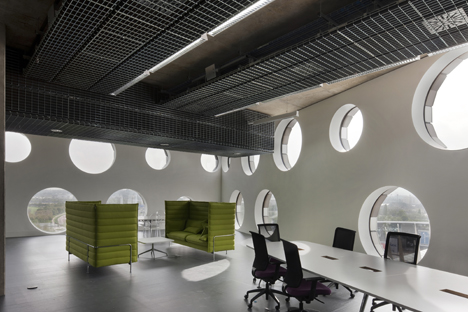
The college has an area of 17,000m2 and will house 1,400 students in inter-disciplinary, open-plan work spaces over four interconnected storeys.
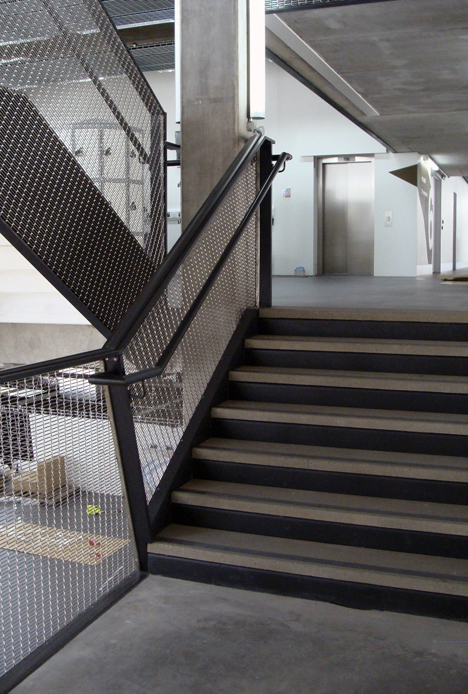
The ground floor incorporates 1,700m2 of public retail space.

An atrium at the north entrance is intended for use by the public while the south side contains a private atrium for students and staff on a raised platform, suspended from steel girders over the ground floor lecture hall.
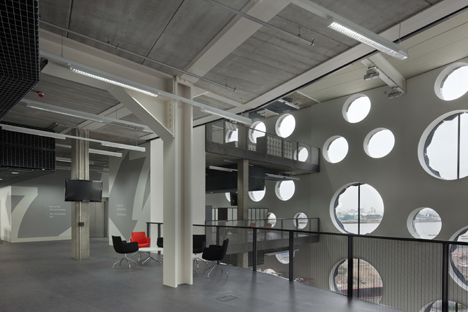
An interior bridge spanning east to west overlooks both the public north and private south sides of the building.

The atrium stairs provide sightlines throughout the building exposing all activities taking place in the college.
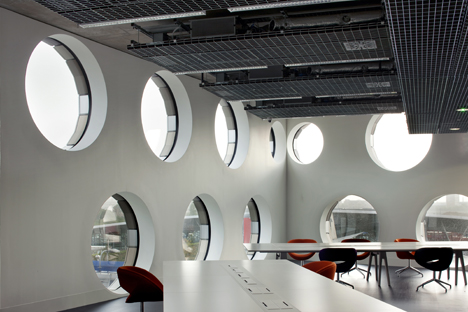
Here’s some text from the Architects:
The new building for Ravensbourne, a university sector college innovating in digital media and design, will be located at Greenwich Peninsula on the South-Eastern edge of The O2 building, to the right of the North-South axis that structures the masterplan.
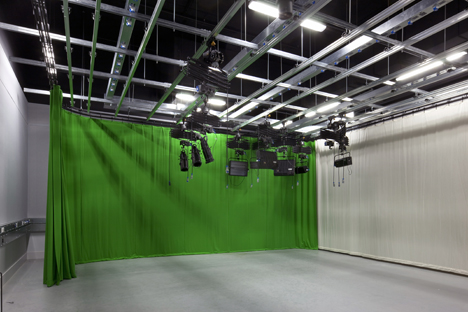
By moving to this extraordinary location, Ravensbourne aims to deliver education to meet the shifting demands of 21st century learners – learners who expect access to resources and support on demand and whose needs can differ greatly depending on a variety of social and economic factors.
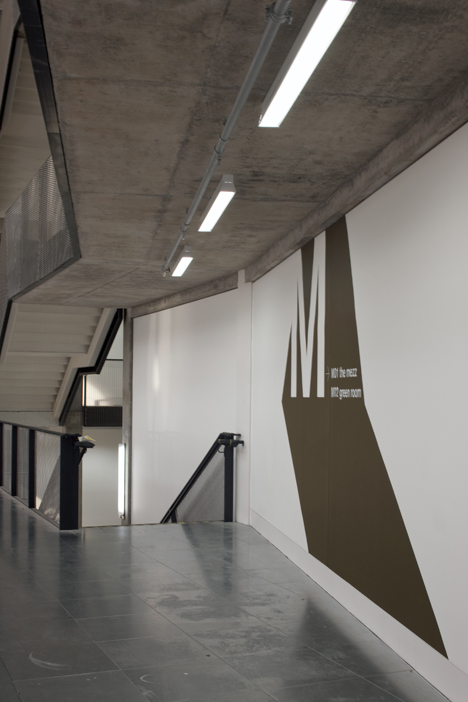
The new building is designed to stimulate the environment and working practices of creative professionals, providing the best in technology and mobile computing in an environment which enables a variety of learning styles.

The main strategy in the design of the building is to produce a structure which will encourage collaboration between the different disciplines and practitioners within Ravensbourne.
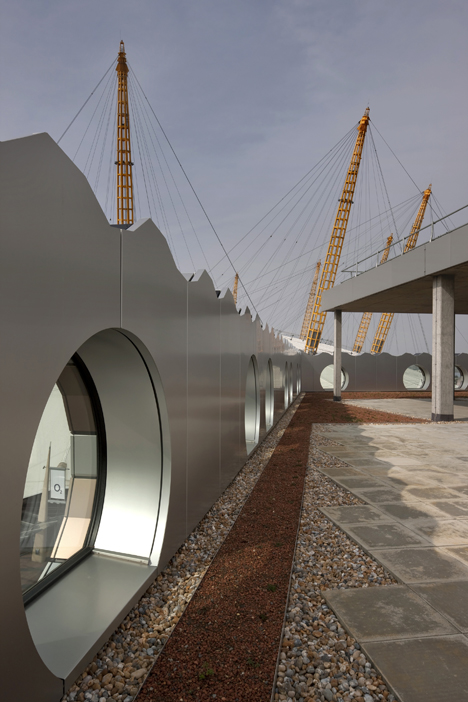
This will be achieved by structuring the building around a system of two interconnected atria, each piercing through three levels of program.
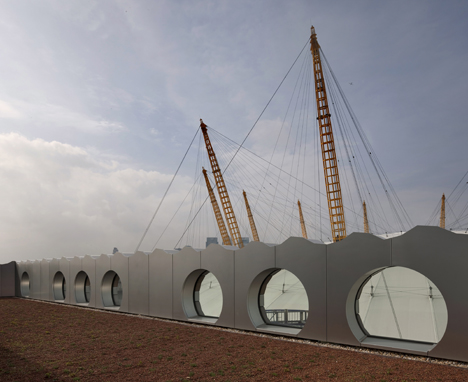
The atria have been systematically attached to the external facade in order not only to use them as ventilation devices, but also to connect visually the core of the public spaces in the building with the perception of the urban surroundings. The building is specified to reach a BREEAM qualification of environmental excellence.
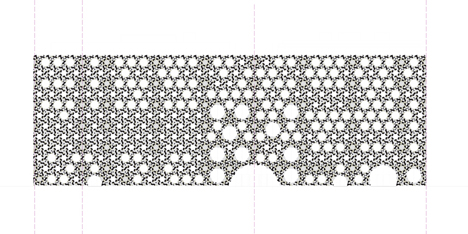
Above: north elevation.
In order to achieve optimum environmental performance, low maintenance and high flexibility, the massing has been kept as compact as possible with a very low ratio of façade to area, and a deep building which is able to provides flexible space to host the various activities which take place in the building.

Above: east and west elevations.
The architecture of the building has been designed to express the culture of contemporary production, by using a non-periodic tiling system which symbolises a more diverse and contemporary approach to technology.
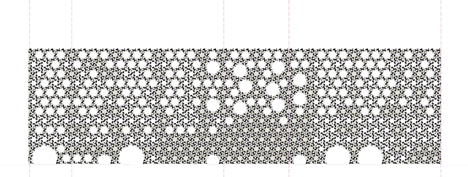
Above: south elevation.
Gothic rose windows and flower patterns have also been a rich field of inspiration for the project, but in this building they will not be produced as an imitation of nature but as an abstract construction.
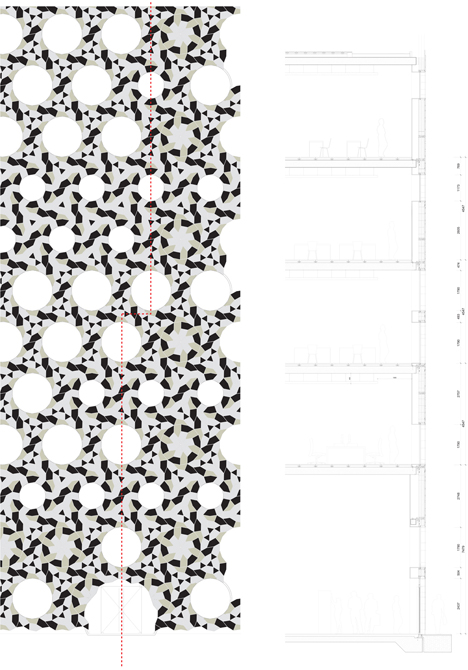
Above: detailed window section.
To achieve this we have resorted to the use of a non-periodic tiling pattern on the façade, which allow us to build seven different types of windows out of only three different tiles.
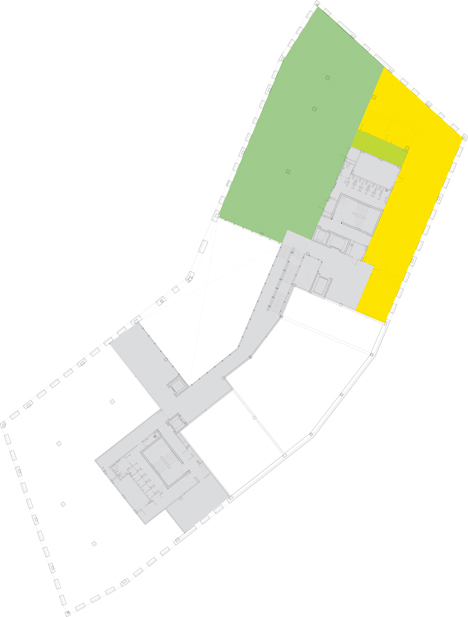
Above: ground floor plan.
RAVENSBOURNE
Ravensbourne is a world-class digital destination developing talented individuals and leading-edge businesses through learning, skills, applied research, enterprise and innovation.
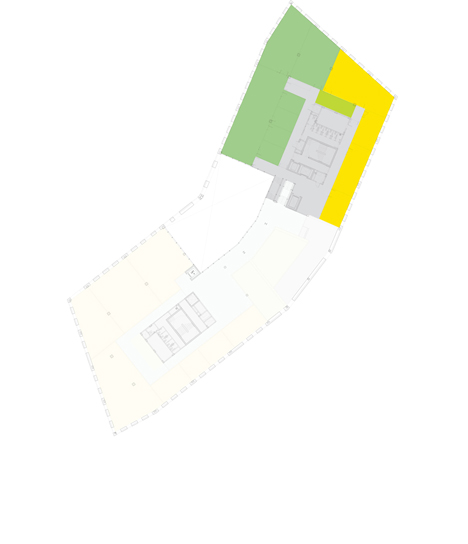
Above: first floor plan.
It is a university sector college innovating in digital media and design, with a vocationally focused portfolio of courses, spanning fashion, television and broadcasting, interactive product design, architecture and environment design, graphic design, animation, moving image, music production for media and sound design.
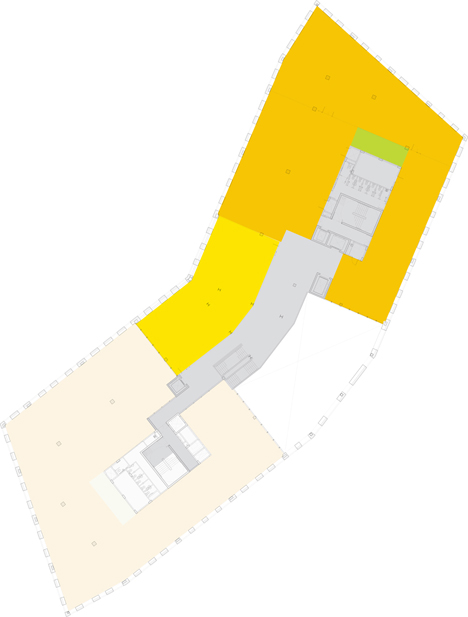
Above: second floor plan.
It is a centre of excellence, industry accredited and a Skillset Media Academy. It has a community of approximately 1,400 students.
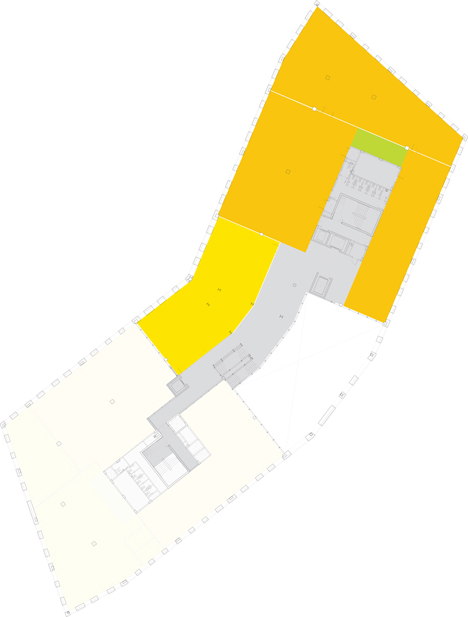
Above: third floor plan.
In September 2010 Ravensbourne is relocating from Chislehurst to Greenwich Peninsula into a purpose built, state-of-the-art building which will offer collaborative work spaces, resources for networking, high-tech creative suites and wi-fi access throughout.
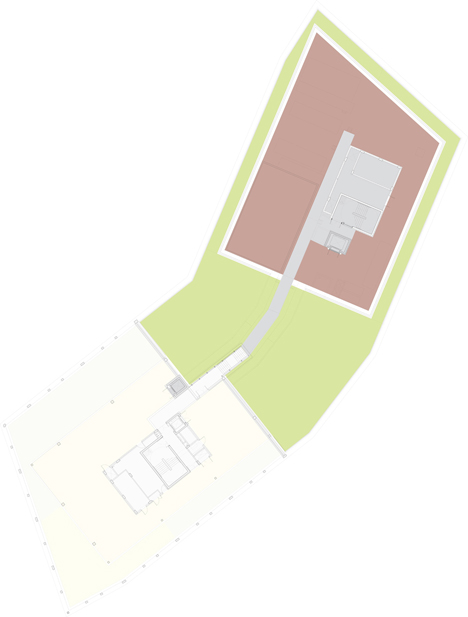
Above: roof plan.
The building will be as much as destination for creative professionals and businesses as it is for students, and is built to the highest environmental standards as part of Ravensbourne’s strategy to minimise its carbon footprint.
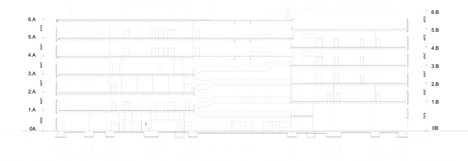
Click above for larger image
The building will house a double-height HDTV studio with 6 channel capacity, moving lights, full autocue and green screen capability, alongside a second studio (4 channel) with virtual studio capability. It will also house a gallery with a studio mixer, a lighting desk and moving lights control.
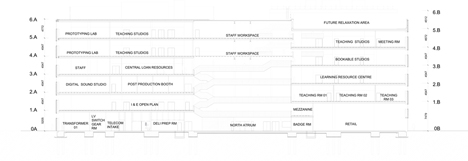
The building’s central Atrium can be converted into one large HD studio. Additionally there will be a digital post production studio with surround sound suites.
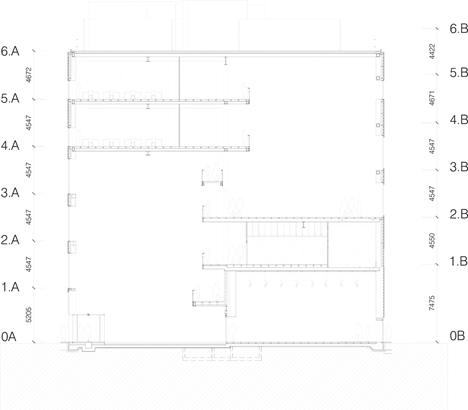
FOREIGN OFFICE ARCHITECTS
Founded in London in 1993, Foreign Office Architects (FOA) has emerged as one of the most innovative and creative design firms working today, integrating architecture, urban design, and landscape architecture in a wide range of projects internationally. The project that established the practice’s reputation was the Yokohama Port Terminal in Japan, an imaginative hybrid of non-Cartesian industrial infrastructure and versatile social functionality, which architects and critics have called one of the most influential works of architecture of the last decade. Since then, FOA has amassed a diverse portfolio of built works around the world, ranging from transportation facilities to social housing projects.

Over the years, FOA has won several prestigious competitions and commissions, including the BBC Music Box, for the network’s White City complex, in London; and it was selected as part of the United Architects team to submit a design for the World Trade Center, New York, in the aftermath of the September 11 attack. In 2002, the practice was selected to represent Great Britain at the 8th Venice Architecture Biennale.
Other completed projects for FOA include the John Lewis Department Store and Cineplex and pedestrian bridges in Leicester, UK; Carabanchel Social Housing in Madrid, Spain; the South-East Coastal Park in Barcelona, Spain; the Meydan Retail Complex and Multiplex in Istanbul, Turkey; the Spanish Pavilion at the 2005 International Expo in Aichi, Japan; and La Rioja Technology Transfer Centre, in Logroño, Spain.
GREENWICH PENINSULA
The £5 billion regeneration of 190 acres of Greenwich Peninsula is led by Lend Lease and Quintain, working in collaboration with the Homes and Communities Agency – a true public / private partnership. The scheme will create a thriving new riverside community for London over the next 20 years.
- 10,000 new homes in distinct residential neighbourhoods
- 24,000 permanent jobs
- Peninsula Central – a new business district for London
- 150 new shops and restaurants
- 1.6 miles of river frontage; the distance between Waterloo and London Bridge
- 48 acres of open spaces and parks; the size of Green Park
- Extensive new community and leisure facilities
- The O2 entertainment destination delivered and operated by AEG Europe
- Excellent transport links, situated in zone 2 on the jubilee line
Client: Ravensbourne in partnership with Greenwich Peninsula Regeneration Limited.
Completion date: 2010
Total Area: 21,500m2
Budget: £70m including technical fit-out
Team Credits: Alejandro Zaero-Polo and Farshid Moussavi with Cristina Parreno, Maider Llaguno, Penny Sperbund, Azizah Sulor, Mio Sato, Emory Smith, John McLean, Daniel Spreier, Sukyeong Kim, Nankuei Lyn, Carmen Sagredo, and Changho Yeo.
No comments:
Post a Comment